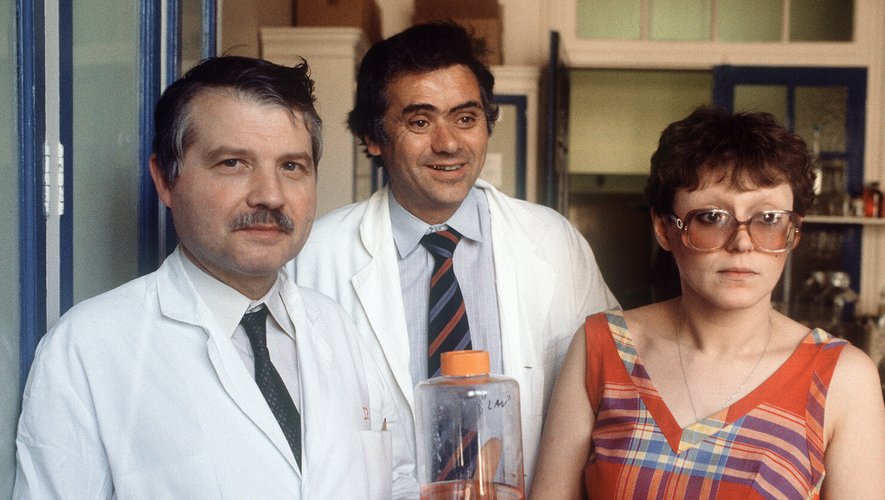(AFP) – 40 years ago, the discovery of the AIDS virus by a team from the Institut Pasteur marked the first stage in the fight against an epidemic that was to kill more than 40 million people.
The “isolation” of the new virus was reported on May 20, 1983 in an article published by the American magazine Science.
The authors of the discovery, Françoise Barré-Sinoussi, Jean-Claude Chermann and Luc Montagnier, adopt a cautious tone: this virus “could be involved in several pathological syndromes, including AIDS”, they write.
Research on AIDS is, at the time, groping. The disease, new, conceals many mysteries.
– “Disease of the four Hs” –
The first alerts were issued in the United States two years earlier. Rare diseases, pneumocystosis and Kaposi’s sarcoma, were reported in the summer of 1981 among young American homosexuals.
Doctors wonder: why these “opportunistic” infections usually reserved for very weak people, among young gay men who have been in perfect health so far?
American experts speak of an “epidemic among gay men and drug users”. The disease has no name yet and is spreading.
We observe that the Haitian population is also affected. We start talking about the “disease of the three Hs” for homosexuals, heroin addicts and Haitians.
A fourth “H” will soon be added: hemophiliacs, who are also affected. We then speak of the “disease of the four Hs”.
The term “aids” (“acquired immune deficiency syndrome”) is used from September 1982. In French: “sida” for acquired immunodeficiency syndrome.
– The hypothesis of a retrovirus –
The cause of AIDS remains unknown. Some embark on the trail of a “retrovirus”, like Robert Gallo, a great American specialist in this family of viruses causing cancer.
On the other side of the Atlantic, in Paris, the viral oncology laboratory directed by Luc Montagnier at the Institut Pasteur is also getting to work.
At the very beginning of 1983, the Parisian infectiologist Willy Rozenbaum took a sample from the lymph nodes of a patient at an early stage of AIDS at the Pitié-Salpêtrière hospital.
His sample arrives on January 3 on the benches of the laboratory of the Institut Pasteur. “At nightfall (…), I get to work”, says Montagnier, who died in 2022, in his book “Des viruses et des hommes”.
With Françoise Barré-Sinoussi and Jean-Claude Chermann, he detects a new retrovirus which they call LAV for Lymphadenopathy Associated Virus.
“We had isolated the virus, we had demonstrated that it was a retrovirus but we were not yet certain that it was the cause of AIDS,” Françoise Barré-Sinoussi told AFP.
– “No one believed us” –
The May publication in Discovery Science is met with skepticism, particularly by Robert Gallo.
Pasteur’s team becomes more and more convinced that his LAV is responsible for AIDS. Montagnier presented data along these lines in September 1983 to a handful of experts, including Gallo. Little reaction.
“For a year, we knew we had the right virus (…) but no one believed us and our publications were refused”, reports Luc Montagnier.
Thunderbolt in the spring of 1984: Gallo submits a series of articles announcing his discovery of a new retrovirus, HTLV-3, presented as the “probable cause” of AIDS.
On April 23, Margaret Heckler, the US Secretary of Health formalizes the announcement with Gallo.
The same day, the latter filed a patent application in the United States for an AIDS screening test, based on his discovery, which was promptly granted. A similar request filed earlier by Pasteur after his discovery of LAV was denied.
Yet quickly Gallo and Montagnier agree that HTLV-3 and LAV are probably one and the same organism.
Proof of their uniqueness was given in January 1985. This new virus was finally named HIV (human immunodeficiency virus) in 1986.
France and the United States disputed the paternity of the discovery until 1987, date of a Franco-American agreement where Gallo and Montagnier were qualified as “co-discoverers” of the AIDS virus.
This dispute is not just a matter of scientific honor. It is above all a financial question because of the royalties drawn from the screening tests resulting directly from the discoveries.
The real epilogue will take place in 2008, with the awarding of the Nobel Prize for Medicine to the Frenchmen Montagnier and Barré-Sinoussi alone “for their discovery” of HIV.

